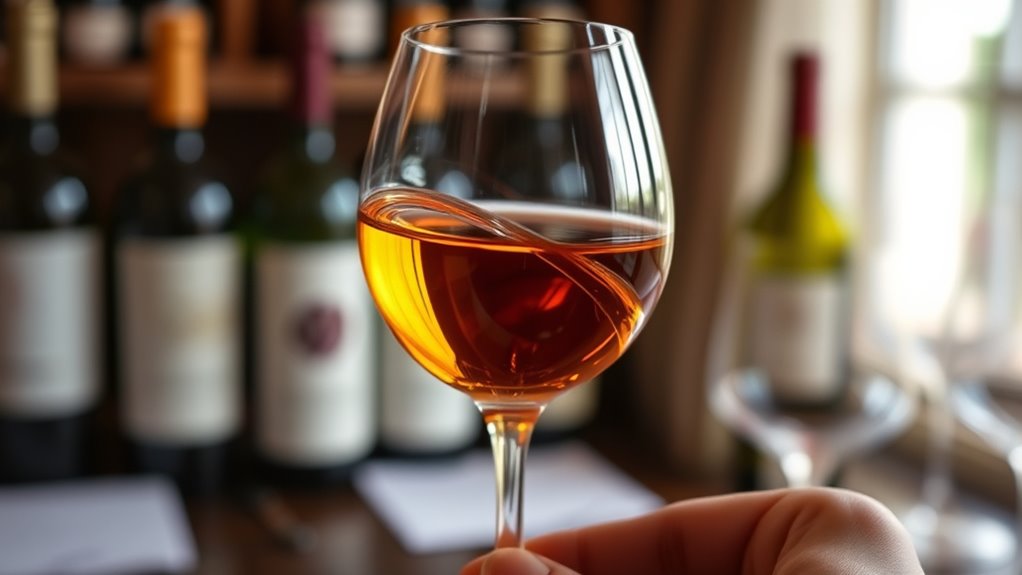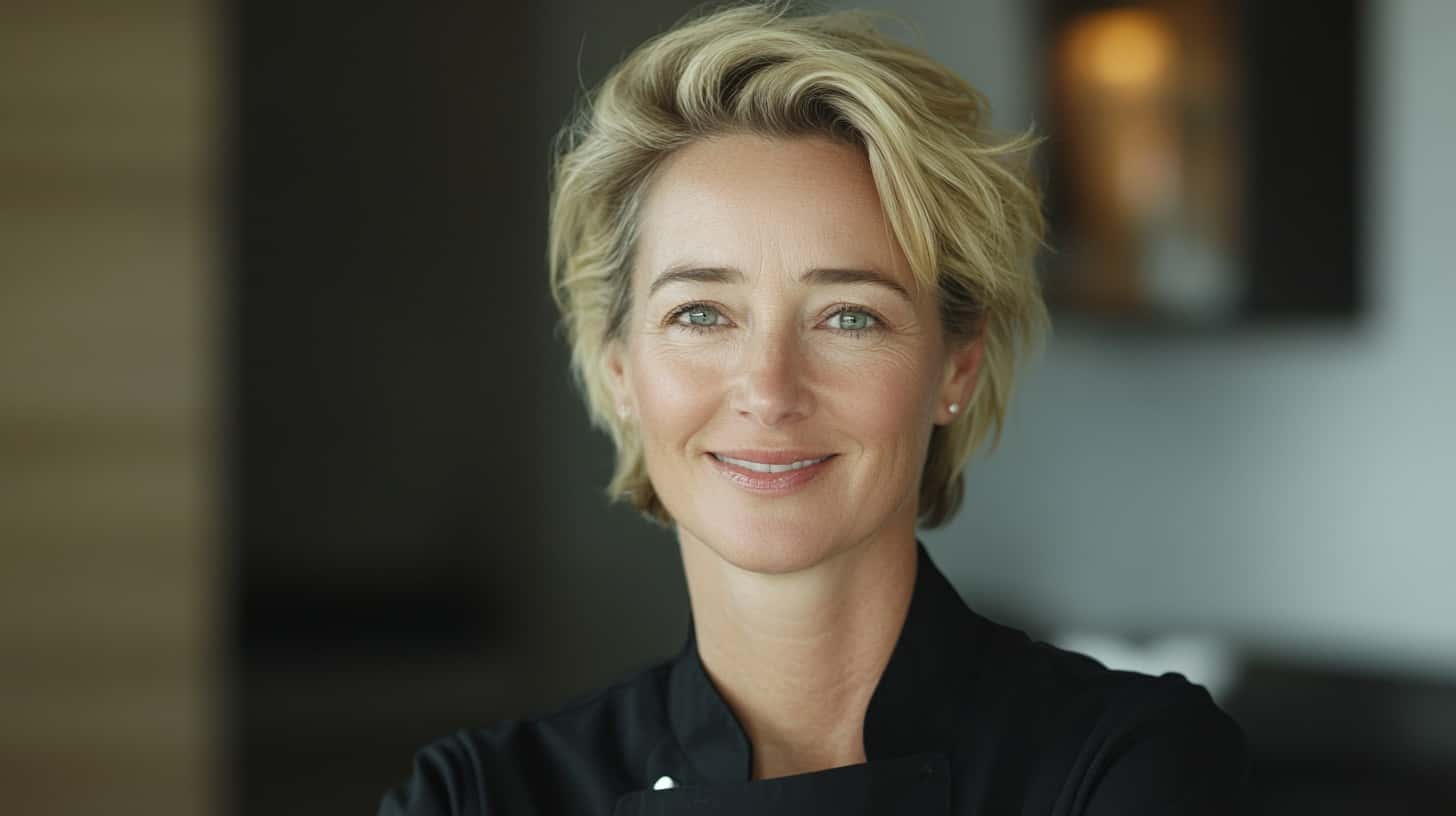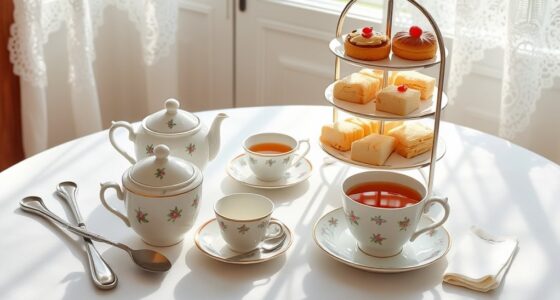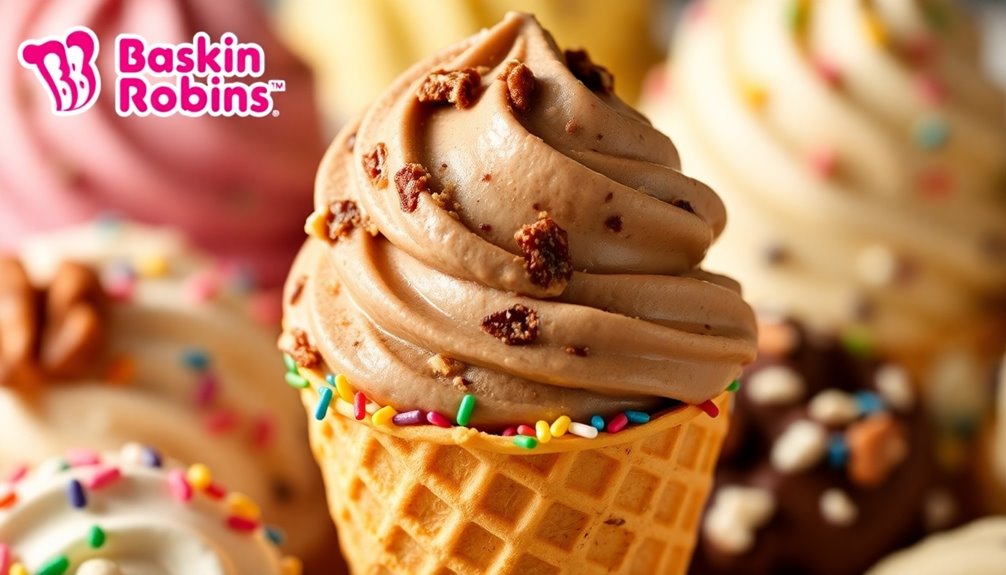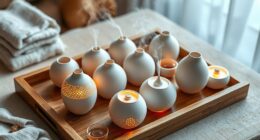To master wine tasting, start by observing the wine’s appearance, noting its color and clarity, then gently swirl the glass to release aromas. Smell deeply to identify scents like fruits, spices, or earthy notes, which guide your pairing choices. Take your time sipping to appreciate the texture and lingering finish, discovering how it balances with different foods. Keep practicing these steps, and you’ll uncover more about wine’s complexity and personality as you continue exploring.
Key Takeaways
- Gently swirl the wine to release aromatic compounds and enhance scent recognition.
- Hold the glass to light to observe the wine’s color, clarity, and potential age indications.
- Smell deeply to identify fruit, spice, earth, and other aromas that reveal the wine’s character.
- Take slow sips to taste the wine’s texture, flavors, and the length of its finish for quality assessment.
- Use aroma and flavor insights to select and enjoy complementary food pairings.
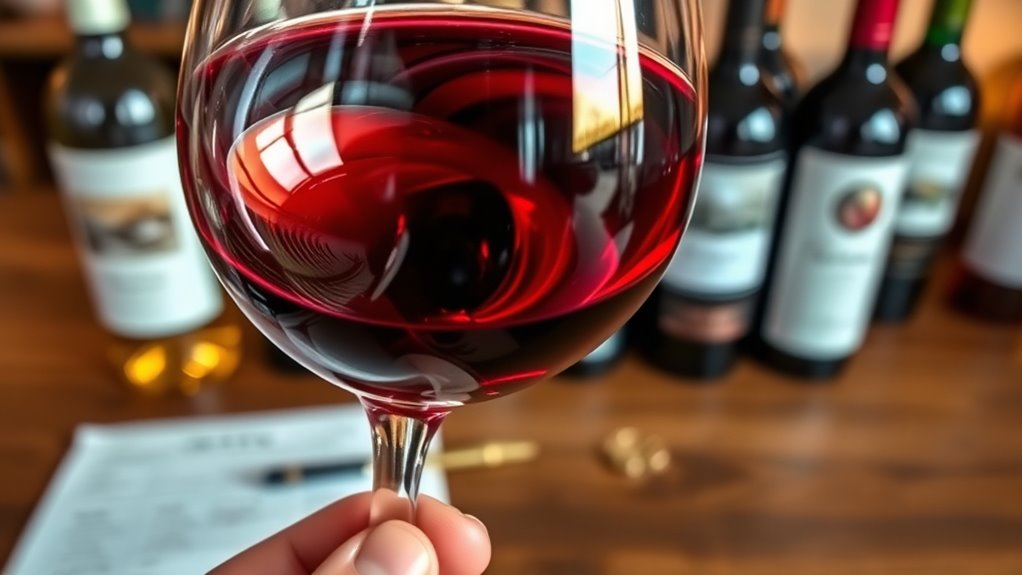
Wine tasting is more than just sipping from a glass; it’s an art that combines your senses to uncover a wine’s true character. When you approach wine tasting with curiosity and attention, you begin to notice how aromas, flavors, and textures tell a story. One of the first steps is to observe the wine’s appearance. Hold your glass up to the light and examine its color and clarity. A vibrant hue can hint at the wine’s age and grape variety, while cloudiness might suggest it’s unfiltered or has been stored improperly. Proper wine storage plays an essential role here; keeping your bottles in a cool, dark place ensures they age gracefully and maintain their intended qualities. If you’re storing wine long-term, invest in a wine fridge or a dedicated cellar to prevent temperature fluctuations that could spoil the wine’s nuances.
Observing wine’s appearance reveals clues about its age, clarity, and quality; proper storage preserves its true character.
Next, you’ll want to gently swirl the wine in your glass. This action releases its aromatic compounds, allowing you to smell its bouquet more vividly. Take a deep sniff, inhaling slowly through your nose. Try to identify different scents—fruits, spices, herbs, or earthy notes—that reveal the wine’s personality. Your sense of smell is powerful in pairing techniques as well; recognizing certain aromas can guide you in choosing complementary foods. For instance, a wine with a berry aroma pairs wonderfully with a variety of cheeses or grilled meats. The more you taste and smell, the better you’ll understand how different elements work together, helping you craft harmonious pairings. Developing your sensory perception through practice can greatly enhance your ability to appreciate wine’s complexities.
When you take your first sip, don’t rush. Let the wine coat your palate, and pay attention to its texture and flavor profile. Is it smooth, tannic, crisp, or rich? The finish—the lingering taste after swallowing—is also telling. A long, evolving finish suggests a high-quality wine, while a quick fade might mean it’s simpler or less refined. As you taste more wines, you’ll start to recognize how pairing techniques enhance the overall experience. For example, acidity in wine can cut through fatty foods, balancing richness and elevating both the dish and the wine.
In essence, wine tasting is a journey of discovery. By understanding how to observe, smell, taste, and think about wine, you’ll deepen your appreciation and become more confident. Proper wine storage guarantees each bottle remains at its best, while honing your pairing techniques allows you to create memorable culinary experiences. Whether you’re just starting or refining your palate, this mindful approach transforms wine tasting from a simple act into an artful exploration.
Frequently Asked Questions
How Should I Store Wine at Home for Optimal Tasting?
To store wine at home for ideal tasting, you should keep it in a cool, dark place with a consistent storage temperature around 55°F (13°C). A wine cellar or a dedicated wine fridge is perfect, as they maintain stable conditions and prevent temperature fluctuations. Keep bottles lying on their side to keep the cork moist, preventing air from spoiling the wine and preserving its flavor for future tasting.
What Glassware Enhances the Wine Tasting Experience?
They say “the proof of the pudding is in the eating,” and the same applies to wine tasting. You’ll want elegant, purpose-built glassware like aerating decanters and stemless glasses to truly appreciate flavors and aromas. Decanters help aerate your wine, revealing complex notes, while stemless glasses offer comfort and focus. Using the right glassware elevates your experience, making every sip a delightful discovery.
Can Wine Tasting Be Enjoyed With Food Pairings?
You can definitely enjoy wine tasting with food pairings, as they enhance the experience by amplifying flavors. When you combine the right wine with complementary dishes, you’ll notice a richer, more balanced taste. Food pairing not only brings out the wine’s nuances but also elevates your overall enjoyment. Experiment with different combinations to discover what best enhances your palate, turning wine tasting into a delicious, sensory adventure.
How Do I Develop My Palate for Different Wine Flavors?
Think of your palate as a garden waiting to bloom. To develop your wine flavor, pay attention to wine aroma and taste with each sip. Try different varieties, note the subtle differences, and keep a tasting journal. Over time, your palate will become more sensitive, revealing complex layers of flavor development. The more you explore, the richer your understanding will grow—turning every glass into a new discovery.
Are There Common Wine Tasting Mistakes to Avoid?
When tasting wine, avoid common mistakes like overly aggressive swirling, which can release too many volatile compounds and overwhelm your senses. Also, don’t neglect wine temperature; serving wine too warm or cold can mask its flavors. Instead, gently swirl to aerate, and serve wine at the proper temperature to truly appreciate its aroma and taste. Paying attention to these details helps you enjoy wine more fully and refine your palate.
Conclusion
Now that you know how to swirl, smell, and sip like a pro, you’re ready to enjoy wine more deeply. Remember, over 80% of taste is influenced by smell, so trust your nose and palate. With practice, you’ll uncover new aromas and flavors, turning each glass into a delightful experience. So go ahead—embrace the art of wine tasting and let every sip tell a story. Cheers to your exciting journey into wine!
